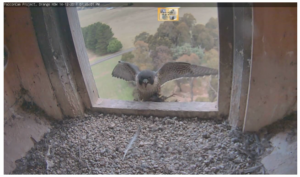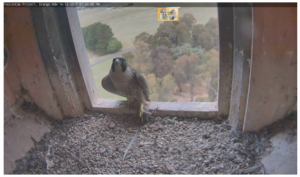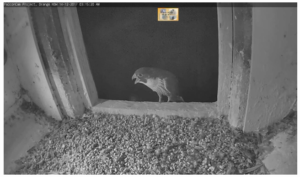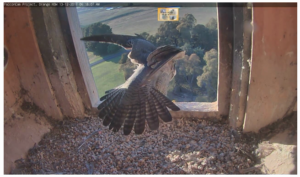I’m still stuck with screen recorder, but I have had a go at making a small video. The format is normally mkv, which I know most of you don’t like, but when I renamed it, it turned into a mp4 (like magic). Is that any better? A couple of screenshots, too. Here Bali is arriving with his prize, which I haven’t identified but is medium sized passerine. This happened just over an hour and a half ago.


Bali arrived in the box last night at just after 3 am. Dirty stop out! It’s amazing how they can fly in the middle of the night. I understand they occasionally hunt at night, although I’ve never witnessed that with our birds.

Xavier was in the box much of yesterday afternoon and both adults have brought prey into the box. Nice shot here of Di leaving.

As I came into the university this evening to reset the recorder, Marragaay was chasing Diamond around and around the tower screeching her head off, before Di escaped into the box. Amazing sight and sound!
Off home soon!
Thanks for great movie!
Bali brought prey into the box,
so …possibly hunt?
And he can move in the midnight.
He grew up!
When I returned home at past 6 pm (8 pm in AU), I saw a juvenile in the box and left.
Soon a juvenile came back again and left.
First Marragaay and second Bali…? Or both M? (both B?)
Juvelnis are out of the box tonight.
He’s looking very grown-up these days – much more pale-bibbed than Marragaay – and I love the look on his face when he lands with his prize!
A book about peregrines arrived the other day – Aussie ones rarely got a mention, but I believe in other parts of the world, some owls will prey on peregrines – I imagine something like a Powerful owl could pose a threat to a night-flying peregrine – do you know whether that’s the case here in Oz, Cilla? Stay safe, little Bali!
Is the book the Peregrine Falcons of the World? I wouldn’t have thought an owl was any where near fast enough to take a peregrine unless it was dozing on a branch, where of course it could be vulnerable.
Juvenile in the box between 1900 and 2010 was Bali, then Diamond arrived and stayed the night (taking back possession?).
The ledge cam has gone out about half an hour ago. No idea why. I’ll give it an hour, then start nagging Scott. I can’t do much with the nest cam at the moment. Trying to identify individuals just by their tails is really quite tricky – especially when they might be facing IN so you can’t see them at all!
I’ll go around and see what i can see with bins.
All quiet on the western front outside. No sign of anyone, but the flies are terrible
And the ledge cam is back on, thank Goodness. I was ready to give up!
Thanks Cilla. It was Bali before D last night.
And it’s good both cams are back!
Bali showed off his achievements to us!
Thank you set this camera,I enjoy to see Diamond and her family’s life everyday.
And, I always want to know, the black spots and white spots on the lawn on the other side of the road, Are they sheep?
I’ve wanted to know that, too. Are they sheep or alpacas? (as I watched a TV news on alpacas in AU)
The black ‘spots’ are cattle (Waygu I think) and white spots are sheep, merino. There are about 4 alpaca on campus too, slightly larger, but I haven’t seen them for a while (white and brown). We also have a few Boer goats (white with chestnut heads) but not in this paddock.
Wow, Waygu! Wow, alpaca!
These animals seem very laid back.
Thank you for your reply.
Various animals! I feel more familiarity with them to know who they are. Thank you.
Hi Cilla – just checked – the book is just called Peregrine Falcon (Patrick Stirling-Aird). He says “In Europe the Eagle Owl and in North America the Great Horned Owl are known predators of Peregrines. … Predation operates especially against incubating or brooding Peregrines and their young.” So – attacking them when they’re at their most vulnerable rather than when they’re out hunting…